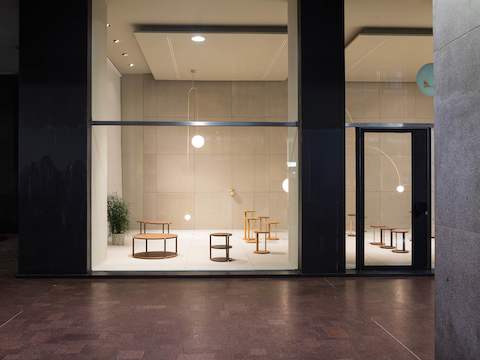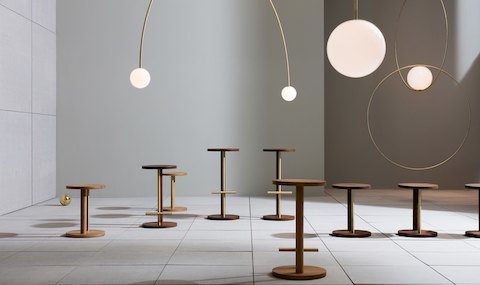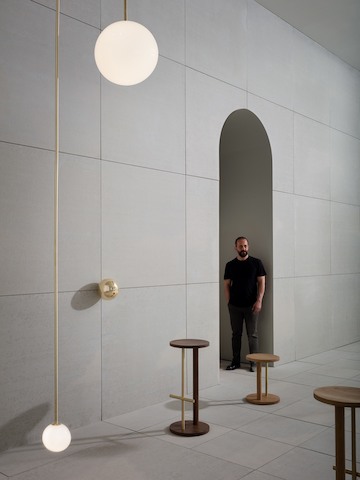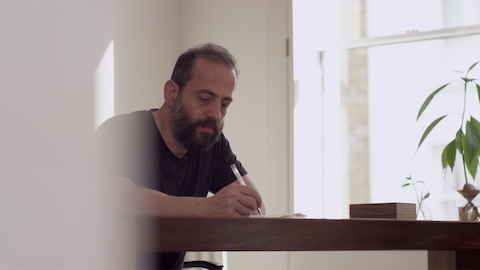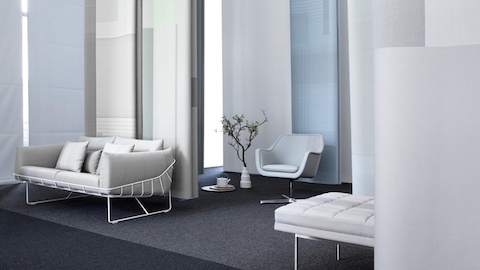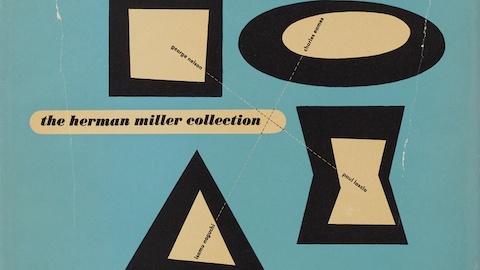Over the last months, Herman Miller worked with London-based designer Michael Anastassiades to bring to life a special environment in which his new collection of furnishings would debut. Well, spring has sprung—at least in Milan, Italy—and the installation is now open to the public. WHY recently sat down with the designer to discuss his approach to the design of the space, his new Spot Stools and Stasis tables for the Herman Miller Collection, and what keeps him coming back to Milan every year.
Can you tell us a little about the rationale behind the exhibit you created in Milan this year?
Michael: What interested me immediately—even though I had really only seen the space in photographs—was the proportions of the room itself. It was almost like a cube because the ceilings are so high. I also wanted to try to create a quite intentional delineation between this space, and the showroom beyond it. My first instinct was to create a kind of white cube, and neutralize all of the surfaces: floors, walls, ceiling. And that became a good starting point to imagine how the products we were creating could look their best in such an environment.
Then a very interesting relationship of scale emerged between the very small objects and the room itself, which is quite large. I almost imagined it as a kind of overpowering sort of game. There was something quite unexpected about it—almost surreal. And because I had the freedom to use some other objects in the space, I thought it would be good to enhance that tension even further by introducing some oversized elements. So I scaled up the lighting to a point where the contrast between the furniture and the room became even more pronounced.
The repetition of the furniture pieces also inspired me. It kind of removes the preciousness from the object, makes it a little bit more accessible, and a little bit more informal. So I immediately thought of chess pieces—the pieces being repeated with slightly different scales—and imagined a kind of chess board to place them on. It seemed like the perfect match, but I didn’t want it to be that obvious, so I started thinking about the idea of a grid that could be mapped all over the room—a kind of three-dimensional chess board. You still have this small grid at the center, but it's wrapped in this larger grid, which in the end brought it back to this kind of envelope for the entire environment.
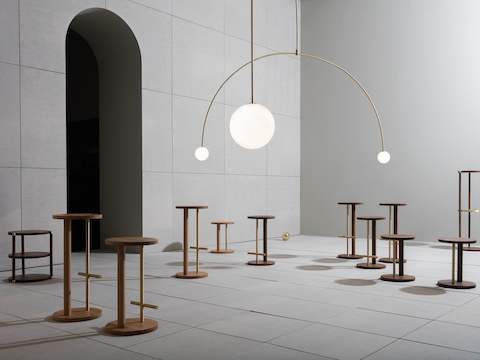
And where did the name, The Double Dream of Spring, come from?
Michael: Well, I mentioned this kind of surreal relationship between the small objects being dwarfed inside the big space, and by the large mobiles, so there was an almost metaphysical quality to the whole environment that was being created. It reminded me very much of surrealist or metaphysical paintings like those by de Chirico, so borrowing the title of a de Chirico painting made perfect sense.
This is your first collection for Herman Miller. How did the project start?
Michael: I received a fairly specific brief asking for a stool in three sizes utilizing wood as the primary material that could live in both office and domestic environments. So my starting point was really about deconstructing all the components—the elements of what a stool is made out of—and trying to reconfigure those elements into an arrangement that made sense in terms of balance. Not balance in the literal sense, but balance in the sense of a kind of holistic object.
And did that immediately lead to the final design?
Michael: Pretty much. We were working in the studio with little scale models coming up with various ideas, and as soon as this particular design emerged, I said, “That’s it. That’s the one.” We literally scaled it up to the proportion of the height we needed without altering anything—somehow the toothpicks and tubes that we used in the little scale model were so right in terms of the proportions. The choice of diameter was right. The relationship between the two vertical pieces was right. The thickness of the seat and the base was right. So we simply scaled it up, and made a 1:1 model from cardboard. Of course, you have lots of work to get from there to a final product.
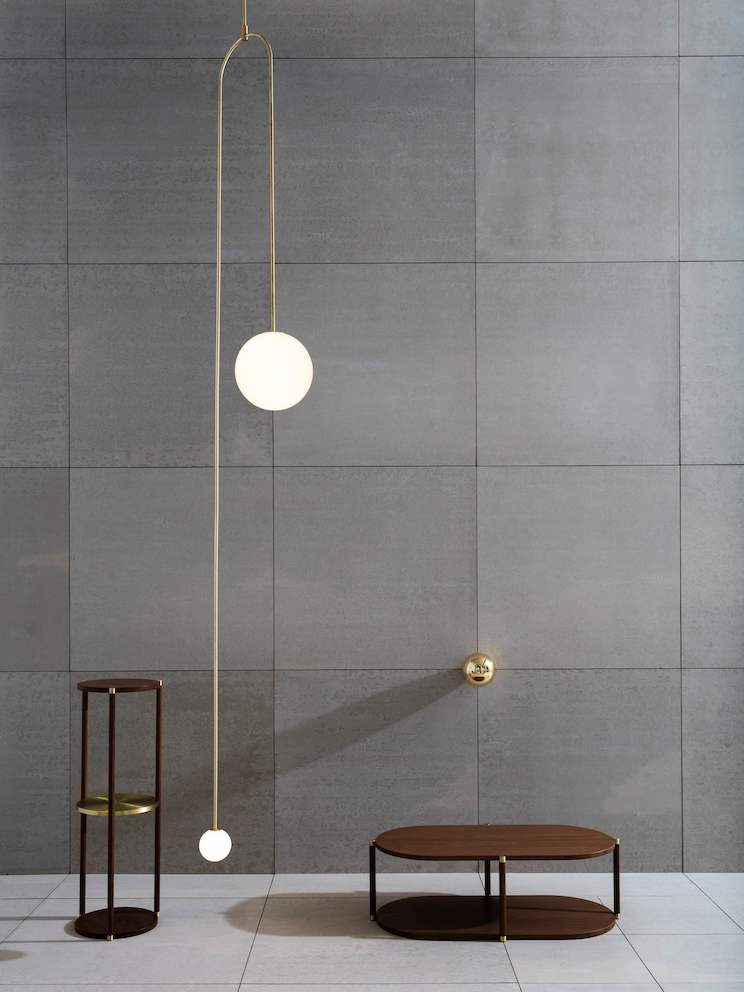
And did the language of the stools inform the design of the tables?
Michael: It was a slightly different exercise. I was interested in how the legs of the table could hold the top—placing them at such a point where if you moved them any further out, the top would fall. And I also liked the symmetry of the arrangement between the top and bottom and the placement of the legs.
You’re obviously well known for your lighting, has designing furniture been a departure for you?
Michael: No, not really. I’m still guided by the same philosophy—just applying it in a different way. Everything I design is in relation to the human body. Not necessarily in terms of the usability of the object, but in terms of our relationship to it both psychologically and physically. What I’m interested in is these subtle qualities of what makes an object desirable.
And in your mind, what are those?
Michael: Well, it’s not necessarily about an immediate impact. There needs to be a certain directness, but one of the best compliments of an object I design should be its anonymity in the sense that it’s not about being in your face, it’s about being a part of the backdrop and if you notice it, then that is when you begin to discover the all qualities that it actually has. That it has been exquisitely realized. That everything has been thought of so it feels in balance with the architecture around it, and with the scale of the human body.
On a different note, how long have you been coming to Milan for the Salone?
Michael: I came here fresh from the Royal College over twenty years ago. There was a lot less happening then, and it was quite different with the fair in town. What was very clear, even at that time, was that it was a celebration of design, but for a very select few designers. I think for me that really opened my eyes to the dynamics behind the design world and how it’s structured.
Now it seems there’s a lot more going on, and it’s a bit more open. Somehow things are a lot more democratic and accessible now, but then there’s another side of me that sees things as more superficial at the same time. You gain from one side, but you lose from another.
When you come to Milan do you have any rituals? Anything you must do?
Michael: I always try to do something that I don’t associate with design. Of course, we all eat well here, but I try to do something like visit a monument or see something else. A few years ago, I decided to go see The Last Supper, for example. I don’t think that many people who are here for Salone, even realize Da Vinci’s great masterwork is right here in the center of Milan. It’s nice to get a little bit of insight into what this city has to offer beyond design.
